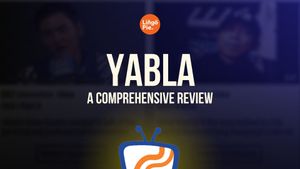So there I was, staring at my computer screen in disbelief. I'd just gotten the email confirming my acceptance to teach in Japan, and suddenly it hit me – I barely knew any Japanese.
Sure, I could belt out a few phrases I'd picked up from years of binge-watching Japanese shows on Netflix, but let's be real, shouting "Nani?!" or "Yamete kudasai!" in the teacher's lounge probably wasn't going to cut it.
With only 60 days until my flight, I was in full-blown panic mode. I mean, how was I supposed to learn an entire language in two months? That's when I stumbled upon WaniKani, this online platform promising to teach me Japanese kanji.
Feeling like I had nothing to lose (except maybe my sanity), I decided to dive headfirst into a 30-day kanji cramming session. And so in this post, I'm going to share my whirlwind experience with WaniKani, spill the tea on its pros and cons, and give you the lowdown on some intriguing alternatives I discovered along the way.

What Is WaniKani?
If you've been poking around the internet looking for ways to learn Japanese, I bet you've stumbled upon Tofugu. Ring any bells? Well, here's a fun fact: Tofugu is actually the mastermind behind WaniKani. Yep, you read that right! That's why WaniKani feels like it was tailor-made for us language-learning nerds – because it kind of was!
But what exactly is WaniKani?
WaniKani is a website that's like your personal kanji trainer, using a spaced repetition system (SRS) and mnemonics to drill Japanese radicals, kanji characters, and vocabulary into your brain. Their whole curriculum is divided into 60 levels and they claim you can learn about 2,000 Jōyō kanji (常用漢字) and 6,000 words in just over a year.
What I personally love about WaniKani is that they make learning kanji easier by focusing on the basics. We're talking about the kanji you'll actually use in real life. So if you manage to power through the whole course (go you!), you'll be functionally literate in Japan! In fact, it actually helped me connect with my students - here's the proof 👇
How Does WaniKani Teach Japanese?
WaniKani uses a clever combo of spaced repetition, mnemonics, and a structured learning path to drill kanji and vocabulary into your brain. You start with the basics (radicals), then build up to full kanji characters, and finally tackle vocabulary.
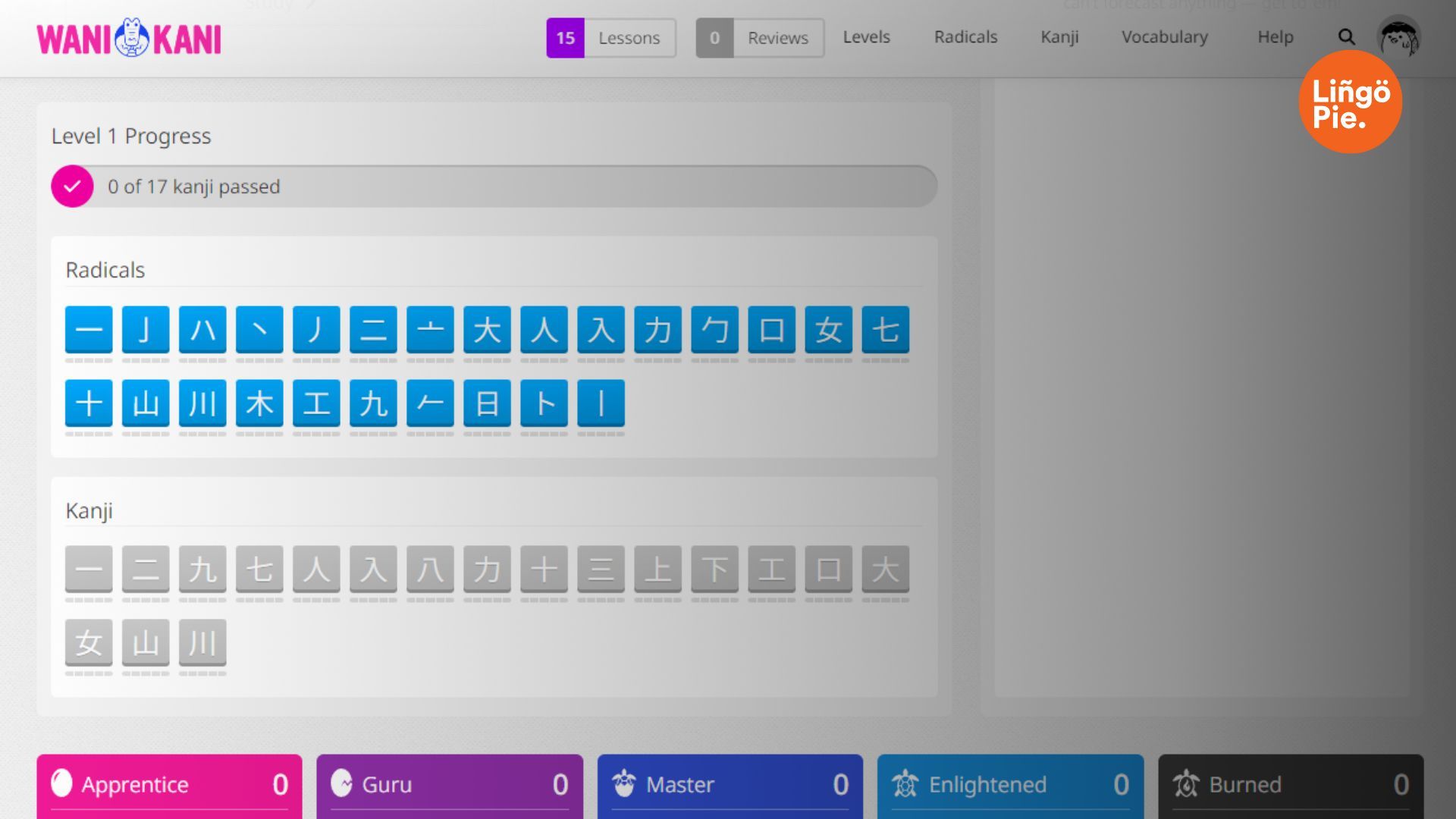
WaniKani Dashboard
Once you're logged in, you'll be faced with two main sections: Lessons and Reviews. It's pretty much what it says on the tin:
- Lessons: This is where you learn all the new stuff. New radicals, kanji, vocabulary - it all starts here.
- Reviews: This is where you prove you haven't forgotten everything five minutes later. (Just kidding... kind of.)
WaniKani Learning Process
Each level kicks off with you learning some radicals. They're basically the building blocks that makeup more complex characters. WaniKani gives you a mnemonic (fancy word for memory trick) to help you remember what each radical means. It's like having a mini-story for each character which is helpful for learning Japanese as a beginner!
Once you've got the radicals down, you move on to kanji built from those radicals. From there, you'll tackle vocabulary words made up of the kanji you've learned.
My two cents? WaniKani's learning process is pretty slick. The way it breaks down kanji into manageable chunks is genius and those mnemonics? Chef's kiss.
But while it's great for kanji, you need to have a strong exposure to actual language use plus knowledge of hiragana characters and the katakana alphabet before starting. That's where more comprehensive language learning apps like Lingopie come in handy, giving you a full-body Japanese workout.

WaniKani Review System
Using the popular spaced repetition system (SRS), the system figures out how well you know each item and adjusts when you'll see it again. Get something right? Great, you won't see it for a while. Mess up? No worries, it'll pop up again soon so you can nail it next time.
To keep you motivated, one way WaniKani helps you out is by moving you to the correct learning stage: apprentice, guru, master, enlightened, and burned. This way, you'll get an idea of how many basic Kanji characters you should know to reach a higher stage.
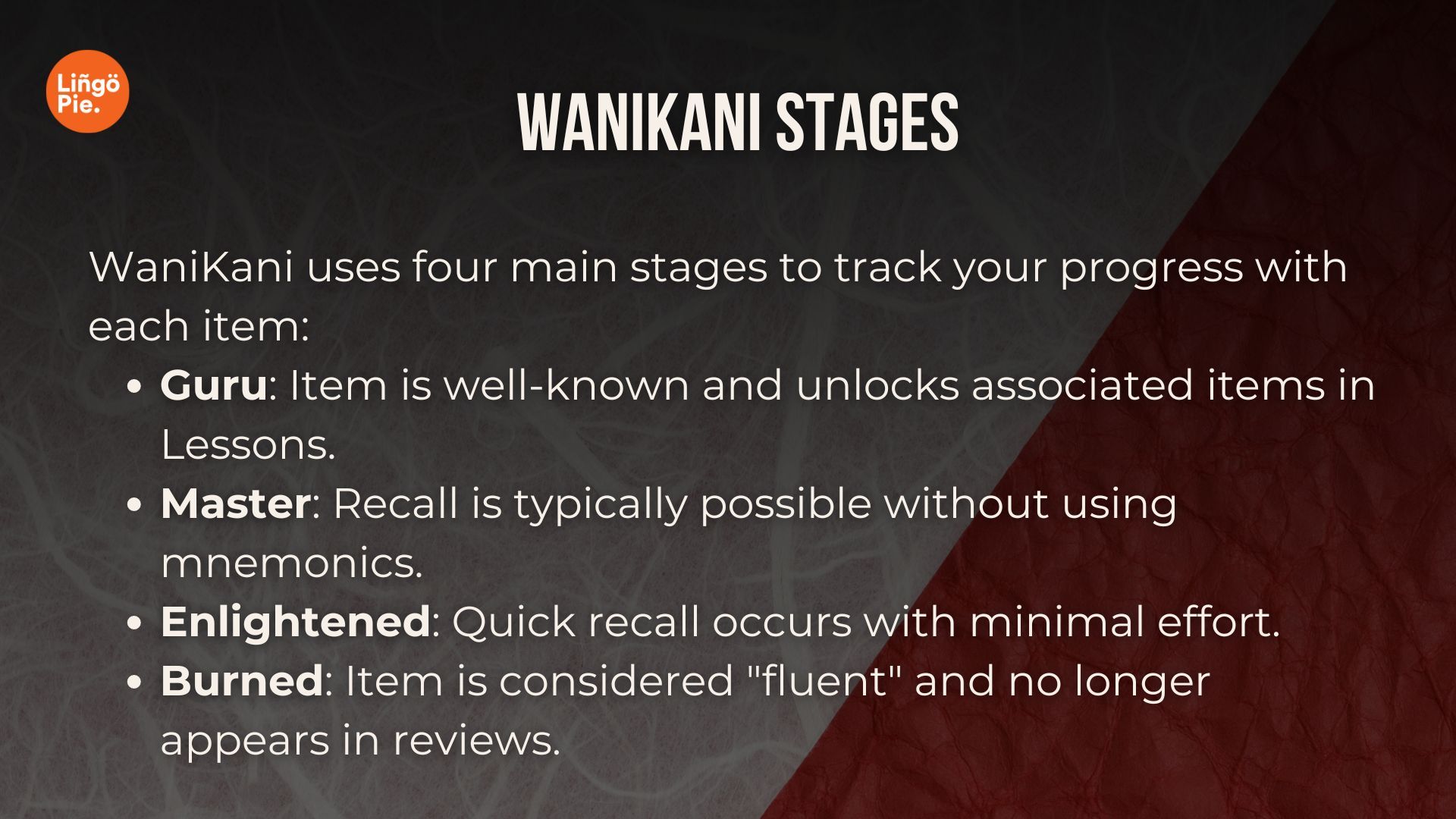
Once you reach the "burned" stage, it means you've fully memorized the item, and it will no longer appear in review sessions. However, you can choose to "unburn" terms, returning it to the apprentice stage for further review.
WaniKani Review Levels
WaniKani splits the kanji into 60 levels wherein each is like a mini-boss fight with about 30-33 kanji to tackle. Just to be clear, these levels don't line up perfectly with JLPT levels or anything like that, okay?

Here's how the review levels work:
- Start with radicals
- Move on to kanji recognition
- Level up
- Unlock vocab
- Rinse and repeat
To move to the next level, you've got to reach "Guru" status. Basically, you need to nail most of the kanji in review sessions that pop up at 2, 4, 8, 24, and 48-hour intervals. Once you've guru'd your kanji, you unlock the corresponding vocabulary. And then you do it all over again at the next level.
The cool thing about this system is that it's timed just right to keep you from burning out. Plus, it helps you remember the kanji long-term. No more learning kanji today and forgetting it tomorrow!
I've got to hand it to WaniKani - their level system is pretty darn clever. It's motivating, it's structured, and it keeps you from getting overwhelmed. But here's my hot take - while it's great for kanji, it's still just one piece of the Japanese puzzle.
If you're serious about learning Japanese and actually start speaking with native speakers, you need to be thrown into the deep end of real Japanese conversations. You can achieve this by signing up for an actual language school and consuming Japanese movies, TV shows, and music.
What WaniKani Covers (And What It Doesn't)
WaniKani covers a ton of kanji - we're talking about 91.90% of Jouyou kanji and 88.20% of JLPT N1 kanji. That's nothing to sneeze at! You'll also get around 6000 vocabulary items to boot. But here's the catch - it's not the be-all and end-all of Japanese learning.
So, what's missing from the WaniKani menu? Well, it won't teach you grammar, how to speak or listen, or all the vocab you need.
Now, if you're looking for a more well-rounded workout for your Japanese skills, you might want to check out apps like Lingopie. It's a whole different ball game. With Lingopie's features, you get to binge-watch your favorite shows and actually see how each character is used in real life by native speakers.
Is it worth paying for WaniKani?
Is WaniKani worth shelling out your hard-earned cash? Well, it depends on what you're after in your Japanese learning journey.
First off, WaniKani isn't exactly pocket change. We're looking at
- $9 a month
- $89 a year (2 months free)
- $299 lifetime/one-time charge
If you're serious about learning kanji and you're the type who thrives on structure and gamification, WaniKani might just be worth every penny. The system is solid, the content is well-curated, and the SRS is top-notch. Plus, that lifetime subscription starts looking pretty sweet if you're in it for the long haul.
However...if you're looking for a one-stop-shop for all things Japanese, this ain't it, chief. You'll still need to invest in other resources for grammar, listening, and speaking practice.
WaniKani Review: Advantages And Disadvantages
I spent 30 days diving deep into WaniKani, and I'm here to spill the tea. Now, keep in mind, this is my personal experience. Your mileage may vary, as they say. Maybe you'll fall head over heels for WaniKani, or maybe you'll be scratching your head wondering what all the fuss is about. That's the beauty of language learning - it's a personal journey.
So, what did I discover during my month-long WaniKani adventure? Read on!
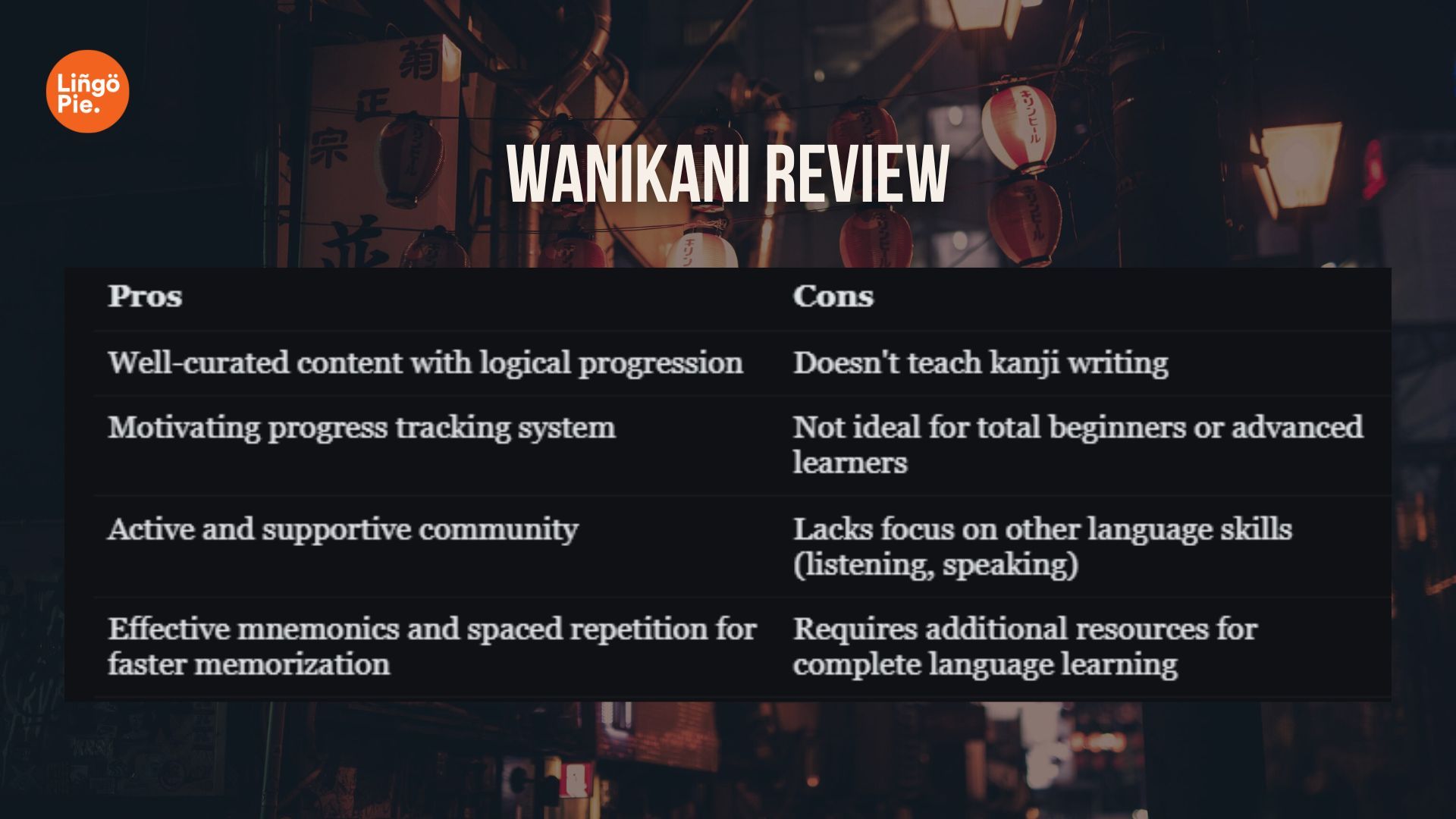
✅ WaniKani Pros For Japanese Learners
The content is well-curated
I appreciate how WaniKani has curated its content. The kanji and vocabulary are introduced in a logical order, building upon each other. This thoughtful sequencing means you're not wasting time on obscure kanji early on, but focusing on characters and words that you'll actually encounter and use frequently.
Progress tracking is motivating
WaniKani's level system and progress tracking are really motivating. Seeing your level increase and watching your kanji knowledge expand gives a tangible sense of progress. It's satisfying to look back and see how far you've come, which keeps me pushing forward even on tough days.
WaniKani has an active community
The WaniKani community is an unexpected bonus. The forums are full of people sharing tips, discussing tricky kanji, and celebrating victories. I've picked up many useful study hacks from other users, and there's always someone ready to offer encouragement when you're struggling with a difficult character.
You actually memorize kanji and vocabulary faster
WaniKani's combination of mnemonics and spaced repetition is incredibly effective. I found myself recognizing kanji in real-world contexts much quicker than I expected. The speed at which you can pick up kanji and vocab with WaniKani is impressive, especially compared to traditional textbook methods.
❌ WaniKani Cons For Japanese Learners
You don't really learn how to write kanji
WaniKani focuses heavily on recognition, but it doesn't teach you how to write kanji. As someone who likes to take handwritten notes, I found this to be a significant drawback. While I could recognize kanji in text, I struggled to reproduce them from memory. This gap in writing skills became apparent when I tried to fill out forms or write messages in Japanese.
It's not for advanced learners and total beginners
WaniKani occupies a middle ground that isn't ideal for everyone. As a learner with some prior Japanese knowledge, I found the early levels a bit slow. Conversely, total beginners might feel overwhelmed by the pace and lack of foundational grammar. It's most suitable for intermediate learners, which limits its usefulness across different proficiency levels.
It does not incorporate other language skills
The laser focus on kanji and vocabulary means WaniKani neglects other crucial language skills. I often felt my reading was improving, but my listening and speaking skills were lagging behind. This imbalance became evident when I tried to have conversations or watch Japanese media, where I could recognize words but struggled to use them in context.
You need to use separate tools to learn Japanese
WaniKani isn't a one-stop solution for learning Japanese. I found myself constantly switching between WaniKani and other resources for grammar, listening practice, and speaking skills. This juggling act was often frustrating and time-consuming. It made me wish for a more comprehensive tool that could cover all aspects of language learning in one place.
Why Switch To Lingopie
For me, the real value of WaniKani was the consistency it brought to my studies. That daily nudge to review kept me on track in a way that free resources often didn't. But I'll be honest, I did find myself eyeing other comprehensive language learning apps that could give me a more well-rounded approach.
This search led me to Lingopie, and it's been a game-changer. While WaniKani excels at kanji and vocabulary, Lingopie offers a full immersion experience. You're learning Japanese in context by watching authentic shows and Japanese movies.
This approach improves not just reading, but listening and speaking skills too. It's suitable for all levels, from beginners to advanced learners. Plus, you pick up on cultural nuances and slang that traditional methods often miss.
| Feature | Lingopie | WaniKani |
|---|---|---|
| Learning Focus | Full language immersion (reading, listening, speaking, writing) | Primarily kanji and vocabulary |
| Content Type | Authentic Japanese shows and movies | Text-based lessons and reviews |
| Engagement | Binge-worthy entertainment | Gamified flashcard system |
| Suitable for | All levels (beginners to advanced) | Intermediate learners (not ideal for complete beginners or advanced users) |
| Cultural Context | Rich exposure to everyday Japanese and cultural nuances | Limited cultural context |
| Grammar Learning | Integrated grammar learning through real-life usage | No dedicated grammar lessons |
| Speaking Practice | Natural speech patterns from native speakers | No speaking component |
| Progress Tracking | Personalized progress dashboard | Level-based system |
The best part? It feels more like entertainment than studying. If you're after a more holistic and enjoyable way to learn Japanese, Lingopie might just be the tool you're looking for. Give it a try for 7 days now!
FAQs
What level of Japanese do I need to use WaniKani?
WaniKani is best suited for learners with basic Japanese knowledge. Complete beginners might find the pace challenging, while it's ideal for those who know hiragana, katakana, and have some basic vocabulary. Advanced learners might find the early levels too slow.
Is WaniKani useful for self-study?
Yes, WaniKani is excellent for self-study. It provides a structured, self-paced approach to learning kanji and vocabulary, with built-in review systems and progress tracking. This makes it easy to maintain a consistent study routine without the need for a tutor or classroom setting.
Are WaniKani’s mnemonics any good for learning Japanese?
WaniKani's mnemonics are generally effective for learning Japanese. They use memorable, often humorous stories to help users associate meanings with kanji. While some mnemonics resonate more than others, the system overall proves useful in accelerating kanji recognition and recall for most learners.
What is the best WaniKani alternative?
The best alternative to WaniKani is Lingopie. Unlike WaniKani's focus on kanji and vocabulary, Lingopie offers a comprehensive approach to language learning. It uses authentic Japanese shows and movies to improve reading, listening, and speaking skills simultaneously. Lingopie provides real-world context for language use, exposes learners to native speech patterns, and makes the learning process more engaging and enjoyable.


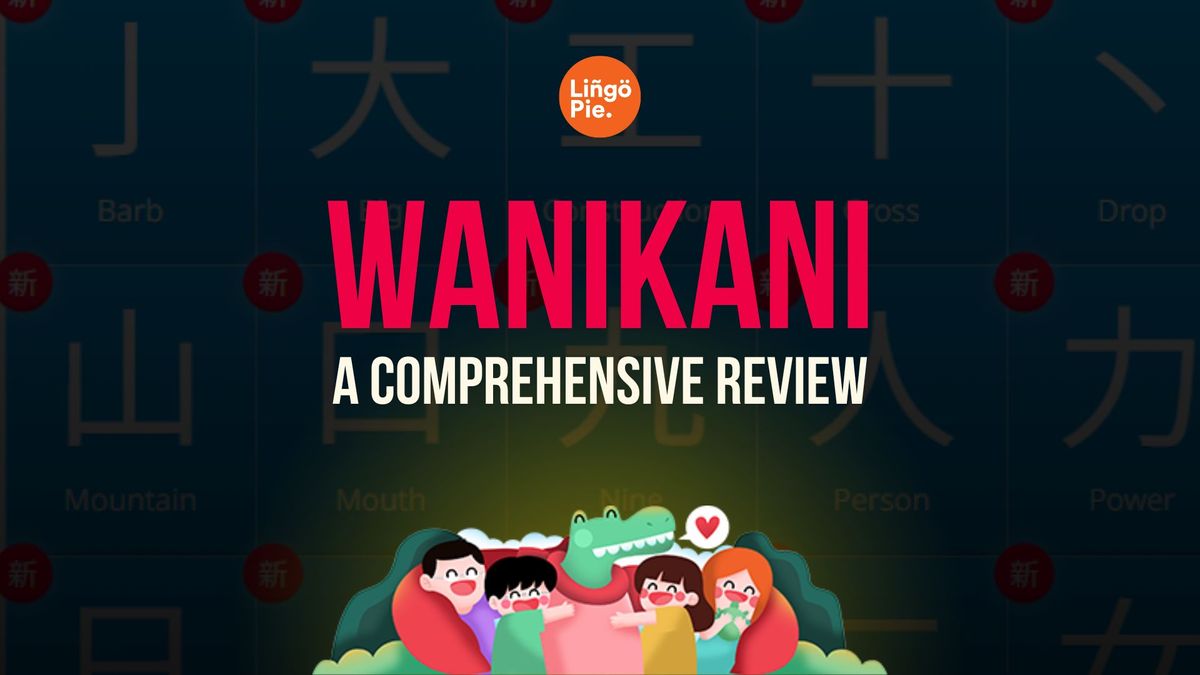




![Language Reactor Review: Why Lingopie Is The Better Choice for Language Learning [2025]](/blog/content/images/size/w300/2024/12/Language-Reactor-Review.jpg)

